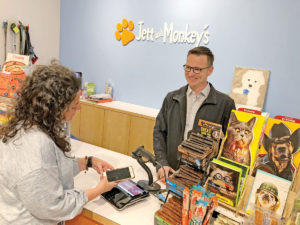Cash, card or DIGITAL PAY?
6/5/2019Five tips small-business owners should consider for transactions.
Small-business owners who want to compete for customers’ money have more options than ever to accept payment.

Jennifer Brooks, left, and Josh Garrett, the
owners of Jett and Monkey’s Dog Shoppe
show how to use an iPhone to make a
purchase. Photo by Melissa Walker.
Check and cash have been mostly replaced by credit cards, and now the shift is toward online, application and contactless methods of payment. While many offer convenience for shoppers, they come at a cost for business owners with fees that can be as high as almost 4 percent.
“It’s an expensive expense, but it’s just one of those things you have to pay for. It’s one of those things you have to do,” Josh Garrett, the co-owner of Jett and Monkey’s Dog Shoppe in the East Village, says of processing fees from credit cards and online payments.
Here are four things to consider when trying to decide which payment methods to accept.
1. Learn what’s available
Business owners can learn about payment options through the free personalized and confidential counseling services at the Mid-Iowa Small Business Development Center. About half of business owners using the service are pre-venture and trying to learn more, while the other half have already started their businesses but have questions, says Jenica Johnson, the center’s regional director.
Most business owners have already researched various payment methods by the time they meet with Johnson.

Jenica Johnson is the
regional director of the
Mid-Iowa Small Business
Development Center.
Photo submitted.
“It’s one of the first things they do,” she says.
While the center does not track trends in payment methods, business owners may discuss various options they’re considering.
“It really varies for which system they’re going to use,” Johnson says. “Most of the time, there is something beyond cash or check anymore. There’s no way they do business anymore without something digital.”
It’s important business owners accept at least the
basic payment options to avoid alienating clientele.
“You don’t want to limit the people who can pay
you by only accepting Apple Pay,” Johnson says. “When you’re a small business, you say: ‘This is what I accept and can’t’ as long as you accept the basics.”
2. Know your customers
With all of the options available, it can be confusing to figure out which payment method is best. That’s why Small Business Computing, an online publication that provides business tips for small business owners and entrepreneurs, recommends
business owners consider which payment options appeal to their customers based on how they interact with the business. When and where the customer shops is important in determining whether the business owner needs to have an e-commerce system set up for online payments, contactless systems for mobile devices or a credit card processing system for in-store purchases.
“Nail down the where and when customer transactions occur, and you’ll pretty much know which payment options to offer and what solutions you’ll need to handle them,” according to Small Business Computing. “At least you’ll know in general what you need; you still have some work to do to determine and select specific vendors and brands.”
Ann Harmon, the owner of From Our Hands in Valley Junction, has accepted cash, credit cards and even checks for the 14 years she’s owned her store.
Eventually, Harmon had to accept American Express cards, even though the fees were more expensive, because more and more customers wanted to pay with it.
Johnson, with the business development center, says fewer businesses still accept checks because fewer customers pay with one. Harmon says she only has a few customers who like to pay with check, but it’s mostly older people.

Ann Harmon, the owner of From Our Hands in Valley Junction, has accepted cash, credit cards and checks for the 14 years she has owned the store. She eventually added American Express cards as well. Photo by Melissa Walker
“The kind of business I’m in, there doesn’t seem to be a whole lot of risk of
people writing me a bad check, so I just take them,” she says. “It does save the merchant money, so that’s great.”
Recently, Harmon had one customer ask to pay with Apple Pay, which she does not accept, so they paid with a credit card. There have only been two times in her years of business when a customer did not have another option to pay with a method she accepted.
“It hasn’t seemed necessary to look into it,” she says of digital payment methods.
Garrett and Jennifer Brooks have owned Jett and Monkey’s for nine years. Initially, they accepted Visa, Mastercard, Discover and cash. They held off on American Express because it had a higher processing fee but started accepting it a year later for their customers’ convenience.
Accepting a variety of payment methods will help a business owner attract more customers because it means more convenience for the buyer, according to intHow, a tech media website that focuses on technology trends, gadget reviews and device updates.
3. Consider different types of sales
Small-business owners who want to accept methods other than cash or check must have the system to do so. There’s a variety of options available today from Square to Apple Pay.
Instore
Square: Square is a credit card processing and Point of Sale (POS) system. It does not charge monthly fees but does charge a per transaction fee that ranges from 2.5 percent to 3.5 percent. Some transactions will have an additional 10 or 15 cent charge.
According to Fit Small Business, a digital resource that launched in 2013 to test products and conduct research for small businesses, a POS software system can cost between $50 and $100 a month per terminal. A POS system helps businesses manage sales. It includes the hardware and software associated with check-out stands.
With Square, the business owner can download the Square app and plug a card reader (the first one is free, subsequent ones are $10) into a smartphone or tablet to make a sale. Customers swipe their cards through the reader, signs if the signature feature is enabled and then select a receipt via their preferred method to complete the sale. For chip cards or contactless payments such as Apple Pay or Google Pay, a Square reader is $49. A terminal costs $399.
PayPal: Business owners can accept in-store payments with a PayPal card reader. Customers can pay with a credit or debit card or make a contactless payment. A chip and swipe reader is $24.99, and there are no set-up or cancellation fees or processing minimums. There is a fee of 2.7 percent per card swipe and 3.5 percent plus 15 cents to key in cards. There are fees for other transactions and international sales.
Online
Business owners who want to conduct online sales also will need a platform and processing system for that. Options include:
Stripe: Stripe is a payment processing system for online sales. There are no set-up or monthly fees. Business owners pay a 2.9 percent plus 30 cent fee per successful card charge. The company offers custom plans that vary depending upon sales volume and other criteria.
PayPal: Business owners can accept PayPal, Venmo, PayPal Credit and major debit and credit cards also with the use of PayPal through their business website after the payment method is set up. There is a 2.9 percent plus 30 cent transaction fee for online sales within the United States, and a 4.4. percent fee plus a fixed fee based on the country currency for international sales.
Amazon Pay: Online and mobile sales have a 2.9 percent processing fee plus a 30-cent authorization fee. Cross-border process fees are 3.9 percent.
Any online payment option should be researched and only the most reliable, secure, fast and error-free services should be used, according to intHow.
4. Decide whether to go contactless or accept cryptocurrency

Josh Garrett, the co-owner of Jett and Monkey’s Dog Shoppe, shows the business’ new point of sale system, which now allows it to take Apple Pay, Samsung Pay and Google Pay. Photo by Melissa Walker.
One contactless method is Apple Pay. This transaction service allows customers to use their devices to make purchases through their phones or an Apple Watch. It works with most major credit card issuers and payment providers. Merchants need a contactless payment-capable POS terminal, which can be done by contacting the POS provider, according to Apple. Merchants will be charged for Apple Pay payments as a credit card transaction, but Apple does not charge any additional fees.
Jett and Monkey’s only recently began accepting Apple Pay, Samsung Pay and Google Pay as payment methods when it updated its POS system.
“If I’m going to change, I might as well get current with the latest technology,” Garrett says.
The new POS system is all-in-one and allows customers to insert a chip card, swipe a card, tap for payment, or use their watch or phone. It no longer requires a customer’s signature.
Business and tech experts say the time isn’t too far away when more businesses will begin to more widely accept cryptocurrency, a digital currency or asset that allows individuals and businesses to pay with virtual currency, the most widely known of which is Bitcoin. The use of cryptocurrencies eliminates processing fees to credit and debit card companies and banking institutions. Cryptocurrency payment gateways such as Bitpay or Coinpayments charge between .5 percent and 1 percent per transaction.
More businesses and companies are accepting Bitcoin: Overstock.com, Expedia, Subway, PayPal, Shopify and Microsoft all accept it, according to Nasdaq Inc.
Nasdaq reports that it’s possible more companies, specifically smaller retailers and merchants, don’t accept cryptocurrency because the fluctuation in its value makes it difficult for them to absorb losses.
5. Pay attention to fees, transaction expenses
Most customers want to pay with a credit card, which has a 1.5 percent or 3 percent transaction fee, plus other fees associated with it that can be tied to volume of sales.
Garrett says transaction fees are high and cut into profits. They can range from 2.5 percent to 4 percent for rewards cards.
“Our third highest bill we have to pay each month is credit card processing fees,” he says, adding that wages and rent are higher.
Garrett and Brooks chose a local credit card processing company to handle their transactions, so some of the 3 percent they pay will stay locally in the form of wages and employing people in the Des Moines area.
In the end, any payment solution has to be easy for the customer to pay but also easy for the business owner to process and account for, according to Small Business Computing. Small business owners need to take the time to ensure they completely understand the system before they buy it or start using it. ♦




















